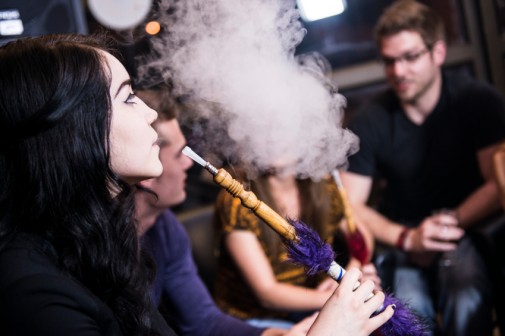A new tobacco trend on the rise

The use of cigarettes continues to decline in the United States, but a new tobacco trend is gaining in popularity, primarily among teens and young adults.
A Centers for Disease Control and Prevention (CDC) study found that the number of high school students using hookahs increased from 4.1 percent in 2011 to 7.2 percent in 2015. Hookah use among middle school students also climbed from 1 to 2 percent during this time period.
A hookah, according to the American Lung Association, is “a water pipe used to pass charcoal-heated air through a tobacco mixture and ultimately through a water-filled chamber.” Smokers inhale water-filtered smoke through a hose and mouthpiece attached to the pipe.
“One factor contributing to a rise in hookah use could be a lack of education about the dangers it poses,” says Dr. Axel Joob, a thoracic surgeon at Advocate Illinois Masonic Medical Center in Chicago. “Hookah smokers may not realize that they are still inhaling a large amount of nicotine, likely even more than they would if they were smoking a cigarette.”
Hookah is generally associated with flavored tobacco mixtures, sometimes called shisha, and is often smoked in groups with smokers sharing the mouthpiece. This combination, when paired with an absence of education, can make this type of smoking seem less dangerous than it really is.
The CDC and American Lung Association note the following health risks associated with hookah use:
- Smoking tobacco through a water pipe still results in exposure to nicotine, the highly addictive drug found in cigarettes.
- Hookah smokers can actually be exposed to more smoke and nicotine than cigarette smokers, as hookah smoking sessions are often longer than it would take to smoke a cigarette and less than five percent of the nicotine is filtered out through the water in the pipe.
- Hookah smoking appears to be associated with lung, bladder and oral cancers, respiratory disease, clogged arteries, heart disease and low birth weight in babies.
- Using a shared mouthpiece when smoking hookah could leave you vulnerable to acquiring infections from others.
- Even if you smoke a flavored, non-tobacco product, the smoke can still contain carbon monoxide and other harmful substances that often lead to health issues.
“The main issue with all of these products is the exposure to the addictive effects of nicotine,” adds Dr. Joob. “People are largely aware of the health risks of tobacco, and smoking is less common than in the past and often discouraged. We shouldn’t let history repeat itself just because the product has changed. The risks are still there, and we should work to educate the public, especially young people, about the harm it can do to your body.”
Related Posts
Comments
3 Comments
About the Author
health enews staff is a group of experienced writers from our Advocate Health Care and Aurora Health Care sites, which also includes freelance or intern writers.


















Great article. What can you share about e-cigarettes? Are they just as dangerous? I have teenagers who believe e-cigs are just flavored steam. Please clarify. Thanks.
Hi Jennifer, thanks for reading! I checked with Dr. Joob regarding your question and hope the following information is helpful. Nicotine, the addictive substance found in traditional cigarettes along with hookah and other tobacco products, is also present in most e-cigarettes. Nicotine is extracted from tobacco and combined with other substances, which can include the flavoring you mentioned. In addition to being highly addictive, nicotine can also have negative effects on the heart, reproductive system, lungs, kidneys and more. Nicotine from e-cigarettes may also have a long-term negative impact on brain growth when used by youth, according to the CDC. The steam, or vapor, emitted by these e-cigarettes can also contain nicotine and other potentially harmful chemicals. While this vapor is not technically smoke, it has not yet proven to be safe for users or bystanders. There are some nicotine-free e-cigarette products on the market, but recent research has shown that even these products can contain substances that are harmful to the lungs. Currently, there is inadequate data to suggest e-cigarettes are less harmful and more research is needed to determine the cancer risk as well.
Just to clarify context here. If you simply remove the tar from the long laundry list of harmful things in regular cigs or hookah then you have a mathematically better/healthier product. Is it good? Probably not. But is it better, yes! If a kid is going to choose to smoke something, then you might as well be happy its the healthiest of the unhealthy options. Granted, its also very unhealthy to breath after a diesel tanker passes you on the street, but what ya going to do!?! Decent article though with useful information and relevant facts.